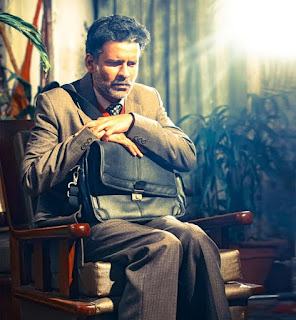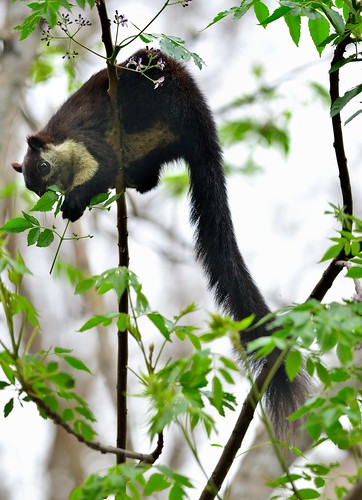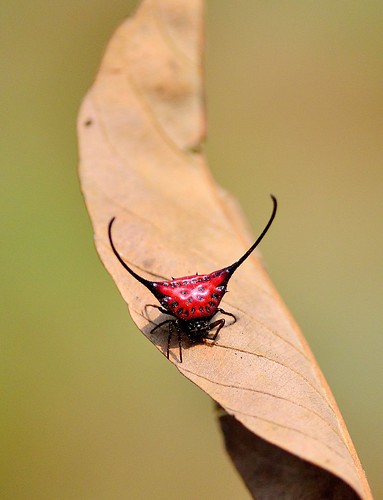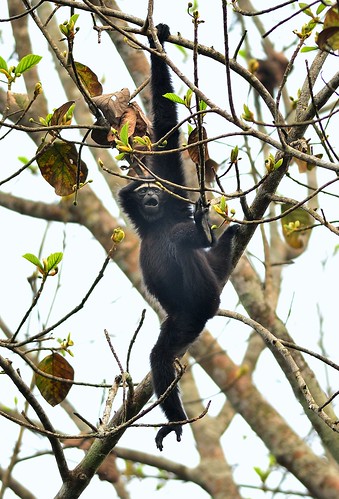The excitement had been building for weeks. After all it was going to be our first sojourn in the North-East. Kaziranga and Hoollongapar with Nature India! Wow!! After an alarm mix-up and a scramble to leave home in time, we finally got on the early morning flight to Guwahati. The flight has an added bonus of offering a beautiful view of the Himalayas. Three and a half hours later we were at Guwahati. Mandar and Adesh were there as expected to pick us from the airport.We set out on our 6-7 hour journey by road to Kaziranga National Park with the rest of the group. It was a long ride, but the picturesque Assamese countryside kept me captivated. Many village houses are still made of bamboo and often plastered with mud/cow dung, with a pretty bamboo fence around them. Most women in the countryside still wear the Mekhla-Chador, the beautiful Assamese drape. The farm animals are interesting too! They are all much smaller and sort of stockier than the ones that I've usually seen: cattle, goats and even dogs. For lunch, our table placed a 'safe' order of chilly-chicken and fried rice while the next table decided to get adventurous with pigeon curry! We had a close sighting of a Grey-headed fish eagle on the way and had our first look at Rhinos against a picturesque landscape a couple of kms before the park gate. What a welcome! The light was fading; dusk falls pretty early in the North-East; but it sure gave us a glimpse of things to come. We checked into this very pretty property of the Assam Tourism Development Board called Jupuri Ghar. They have nice, clean huts, great service and good food with an interesting variety. (The bamboo-shoot chutney is kind of an acquired taste though. It smells like elephants!) It happened to be Holi that day, and we were pleasantly surprised with homemade 'Puran-Polis' sent by Adesh's mom, complete with Ghee! The next morning, we set out on our first safari into the National Park.
We went to the Eastern Zone, called Agartoli, which is about 20 km from the Central Zone gate. It is exceptional, with a lovely mix of tropical evergreen forest- vegetation filling up all its possible niches, grasslands and a number of water bodies.
Blue-throated and lineated barbets seemed to be dominating alternate patches of the forest, their repetitive calls lending character to the feel of the jungle. The more than six-feet high termite hills were the largest I've ever seen. And then, we saw the astonishing heaps of dung. It seems, each rhino defecates in only a particular place to mark its territory! Fun fact, but unfortunately a convenient pointer for poachers as well.
The sightings of that day started with the photo-op specialist, the spotted owlet. Another lovely owl, the Asian Barred Owlet decided to play hard-to-get for the photographers. Then the forever 'middle-aged and balding' Lesser Adjutant Stork obliged us on a great perch. These jungles are teeming with Lesser Adjutant Storks and Eurasian Openbills.
We were startled by the shrill metallic calls and bright contrasting colors of the Hill Myna. The otherwise rare Pallas's fish eagle gave us our first of its many sightings in the park. Not to be left out, a Grey-headed Fish Eagle and an Osprey showed up too.
An Oriental Pied Hornbill flew into a nearby canopy. Next to delight us was a lifer, the Northern Lapwing. What a regal crest it has! Unbelievable!!
A humongous Asiatic Water Buffalo was too busy relaxing to be bothered by our presence.
All this morning excitement made us hungry and so we stopped at a nearby watch-tower overlooking a pond, for a sumptuous breakfast of (over-)stuffed cheese sandwiches, boiled eggs, fruit, and a cool drink.
Food and wildlife, the perfect combination!
Black-necked storks, Bar-headed and Greylag Geese and many ducks*, waders** and herons*** were busy feeding in and around the water. Our next lifer of the day was the Spot-Billed Pelican. A flock of them was fishing: Flapping their wings and trapping the fish before lapping them up. (Poetic!) An elephant mother and calf ambling along provided us with some excellent shots in the soft morning light.
And then a beautiful large raptor, mobbed by eastern jungle crows, landed near the pond. Initially we thought it to be a Pallas' Fish eagle, but on close scrutiny it turned out to be a juvenile Eastern Imperial Eagle (which also went on to have its breakfast later), the heavy streaking clearly visible through the spotting scope. These eagles are fairly uncommon in these parts. The widely found Indian roller is much darker here, and is actually a different subspecies, the Black-billed roller(Coracias benghalensis).
A little ahead, we suddenly heard a gun-shot which the driver said was sometimes fired by the armed guards into the air in case an animal charges at a vehicle. Anyway, it was the mating season of the beautifully colored red-breasted parakeets, and they were all around the place. Imperial Green Pigeons had a strong presence along with Spotted and Red collared-doves.
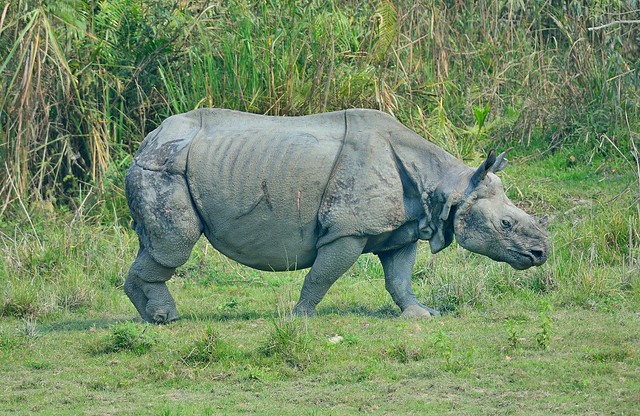
Then we had a couple of close sightings of the Indian One-horned Rhino, often followed closely and even ridden by the Common myna, Jungle myna or the North-East resident, the White-vented myna. The glorious animal really looks like a battle tank! One of them looked old and battle-weary: scars on its flanks and a half-broken horn, thanks to either a fight or parasites. Then was the turn of the majestic beauty, the Great Pied Hornbill. I was enchanted by the great whoosh of its wings as it took flight. Magical! I'd never seen otters before and was really looking forward to sighting these interesting mammals. Especially after reading in a Jim Corbett book that they are one of the few animals that kill for sport! We saw a bevy of Asian Short-clawed Otters on an island, rolling in the dust. Nice! A short while later, the gypsy in front of us had kind of close encounter with an elephant.

He sort of broke into a little jog towards them, but eventually stomped into the jungle. Next, we saw a terrifically camouflaged Indian Monitor Lizard peering at us from a tree hole. More rhinos and water-buffaloes, along with a lone Black Redstart followed. The park has a good population of darter birds too. There are many hog deer and swamp deer (soft ground Barasingha) in Kaziranga. We saw the gorgeous but shy male and female Khaleej pheasants in the bush. A Spangled Drongo showed up next, showing off its blue-black sheen. The Eastern range had been very rewarding indeed!

The afternoon safari that day was in the Central (Kohora) range. It is more grassland than forest. The forest department had set fire to the grass in many places. The logic that our driver gave us was that it ensures that the forest doesn't take over the grassland, thus maintaining the rhino habitat. We were greeted by Slender -billed vultures and Himalayan Griffons near the gate. There were Grey-headed lapwings in the grass slightly ahead.
Next we saw lots of Assam roofed-turtles and Indian tent turtles on fallen tree branches in the water.
Suddenly, we saw a cloud of dust and we realized that a Rhino had (mock-)charged at the vehicle ahead of us that Mandar was leading!Phew!! The light had begun to fade, and we stopped at a lovely watch tower that offered serene shots of a Rhino mum and calf.
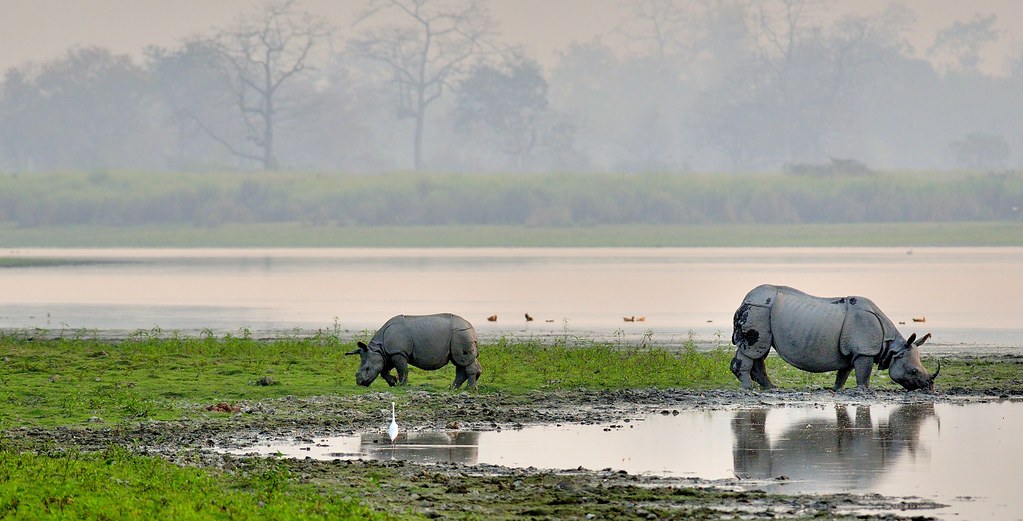
On our way back, we saw another watch-tower filled chock-a-block with people. They'd spotted a tiger! It was very far, but we did get a look through our binoculars, and well, we'd sighted a tiger in Kaziranga!! The next day started with a brilliant session in the forest behind our resort with Adesh. We were literally surrounded by the calls of various winged-beauties! Grey treepie, Striped Tit Babbler, Crimson-backed flower pecker, White-throated bulbul, Black-crested bulbul, Green-billed malkoha, Dollar bird; and the more widespread Emerald dove, Common Hoopoe and Yellow-footed Green Pigeon. The Grey-headed Woodpecker with its dark moustachial stripe seemed to have a perpetual smile! The striking yet reticent Yellow-Vented Flowerpecker emerged for a very short while from the leaves. What an exciting time we had! Another trip to the Central Zone followed and we saw most of the species from day one, and some more. There were Blue-bearded, Blue-tailed, and Green bee-eaters, Oriental Honey Buzzard and Crested Serpent Eagle. The fiery Greater Flameback brightened up our eyes. We also saw the Large Cuckoo Shrike and Black Storks in flight. The highlight of this safari was undoubtedly the rare Swamp Francolin though, who graced us with a nice long sighting. The surroundings of the resort provided more birding opportunities between safaris. Alexandine Parakeet, Long-tailed minivet, Rosy minivet, Ashy woodswallow, Barn swallows kept us on the toes. Our stay at Kaziranga had come to an end. Some souveneir shopping and another visit to the backyard forest later, we'd bid farewell to Kaziranga and set out for Jorhat.
The hotel at Jorhat, the Earl Grey, was a typical town hotel, very different from the lovely Jupuri huts. It was a base for us to visit The Hoollongapar Gibbon Sanctuary. We set out the next morning, and we stopped en-route near a swamp to have a dekko at some Purple swamp-hens, Common moorhens, Painted snipes, and so on.
There was widespread apprehension about possible leech encounters, and we'd set out armed with leech socks and pain-killer sprays. However, it turned out to be quite a dry day, and no bloody battles ensued.
We reached in under an hour, and I was simply captivated by the beauty of the forest. The tall hoollong trees, with their bunny-ear like seeds that spiral down in the most charming manner, dominate the upper canopy of the forest, while the Nahar (Naag-Keshar) commands the middle canopy.This forest is like an island:there are tea-estates all around it. It is also home to seven species of primates.
Capped langurs, Pig-tailed macaques and Malayan Giant Squirrels played host near the park gate.The park is rich in insects, and pretty little butterflies were flying all around us throughout our stay here.
Malayan giant squirrels were oblivious of all human presence and came pretty close to the human settlements huts to feed without any fear. They gave all photographers ample photo opportunities at close distances.
An interesting spider called the horned spider was something that we never imagined to exist. It had a beautiful red strawberry exterior and looked absolutely fabulous. There were huge wood spiders everywhere waiting in their nets for some unsuspecting victim to fall prey.
Butterflies, insects, spiders of all shapes, sizes and colors were seen and the truly the biodiversity of this forest is absolutely mind boggling.
The highlight of the day was, without a doubt, the Hoolock Gibbon. We were lucky enough to see an entire family thanks to Shri Deben Bora, who has done a lot of valuable work around the Hoollock Gibbons. He led us to a family of four, which probably recognizes him! And how amazing they look! The extra long arms, the unusual eyebrows, their acrobatic movements, and the little baby stuck fast to its mum, I just couldn't stop grinning!
After we'd seen them to our heart's content, we went on to spend more time on the birds and were rewarded with sightings of the Red-headed Trogon, Sultan Tit and the Abbott's Babbler! Whoa!!
And of course, the perfect accompaniment to these wonderful sightings was the delicious meal the local cooks and our drivers prepared for us. They made some five extremely tasty vegetable dishes along with dal, rice and a mouth-watering chutney. Fabulous! Luckily, the rain came pouring only after we'd wound up an extremely satisfying day. Our end-of-the-trip heavy hearts and aching feet were treated to some retail therapy on the way back to Jorhat as we shopped for some fragrant local rice and woven bamboo products.

At the hotel, we found that the papers had reported an incident of rhino poaching in Kaziranga from a couple of days before. Oh no. That gunshot we'd heard...was it really the forest guards...?
An entire day of travel to Guwahati and then to Mumbai lay ahead the next day. It was sweetened in part en-route by the most amazing coconut water that I've ever had. As I bid adieu, I felt a deep yearning to stay back longer in this magnificent land, and I promised that I'd be back.
*Ducks: Ruddy Shelduck, Spot-billed Duck, Lesser Whistling Duck, Mallard, Red-crested Pochard
**Waders: Common redshank, Wood sandpiper, Black-tailed Godwit, Ruff, etc.
***Herons : Pond heron, Purple heron, Grey heron.
P.S: Photos are courtesy Mayur Shinde. I'm certain that I haven't covered all the species that I saw. I hereby solemnly swear to carry a notebook on the next trip!
